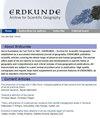从前瞻性指标看欧洲人口老龄化的区域差异
IF 1.1
4区 社会学
Q3 GEOGRAPHY
引用次数: 5
摘要
人口老龄化是近几十年来人口发展中讨论最多的方面之一。生殖行为的复杂变化及其对年龄结构和未来人口发展的影响往往是人们对社会经济体系(如养老金体系、医疗保健和劳动力市场)稳定性的担忧。标准人口老龄化指标的制定和使用以及在时间和空间上和/或在人口之间的比较经常加强了这一点,鉴于人口死亡率和健康状况的重大变化,这种片面的观点是有问题的。此外,人口老龄化传统上是根据国家和区域差异进行分析的,而具体情况往往被忽视。使用基于预期年龄的人口老龄化分析新方法,我们试图确定欧洲老龄化区域分化的主要空间模式(在NUTS2水平上)。预期年龄解释了预期寿命随时间的变化,因此更准确地反映了人口老龄化。我们还试图使用主要的老龄化指标创建欧洲地区的类型,从而确定受人口老龄化影响最大的地区。本文章由计算机程序翻译,如有差异,请以英文原文为准。
Regional differences in population aging in Europe viewed through prospective indicators
Demographic aging has been one of the most discussed aspects of population development in recent decades. Complex changes in reproductive behaviour and their impact on both age structure and future population development are often the source of concerns about the stability of socioeconomic systems (e.g. pension systems, healthcare and the labour market). Frequently reinforced by the development and use of standard demographic aging indicators and comparisons over time and space and/or between populations, this one-sided view is problematic given significant changes in population mortality and health. Population aging has moreover traditionally been analysed in relation to national and regional differences, with specificities frequently being overlooked. Using new methods for analysing demographic aging based on prospective age, which accounts for changes in life expectancy over time and therefore more accurately captures demographic aging, we attempt to identify the main spatial patterns of regional differentiation in aging in Europe (at the NUTS2 level). We also attempt to create a typology of Europe’s regions using the main aging indicators and thereby identify the areas most affected by demographic aging.
求助全文
通过发布文献求助,成功后即可免费获取论文全文。
去求助
来源期刊

Erdkunde
地学-自然地理
CiteScore
2.00
自引率
7.10%
发文量
17
审稿时长
>12 weeks
期刊介绍:
Since foundation by Carl Troll in 1947, ''ERDKUNDE – Archive for Scientific Geography'' has established as a successful international journal of geography. ERDKUNDE publishes scientific articles covering the whole range of physical and human geography. The journal offers state of the art reports on recent trends and developments in specific fields of geography and comprehensive and critical reviews of new geographical publications. All manuscripts are subject to a peer-review procedure prior to publication. High quality cartography and regular large sized supplements are prominent features of ERDKUNDE, as well as standard coloured figures.
 求助内容:
求助内容: 应助结果提醒方式:
应助结果提醒方式:


